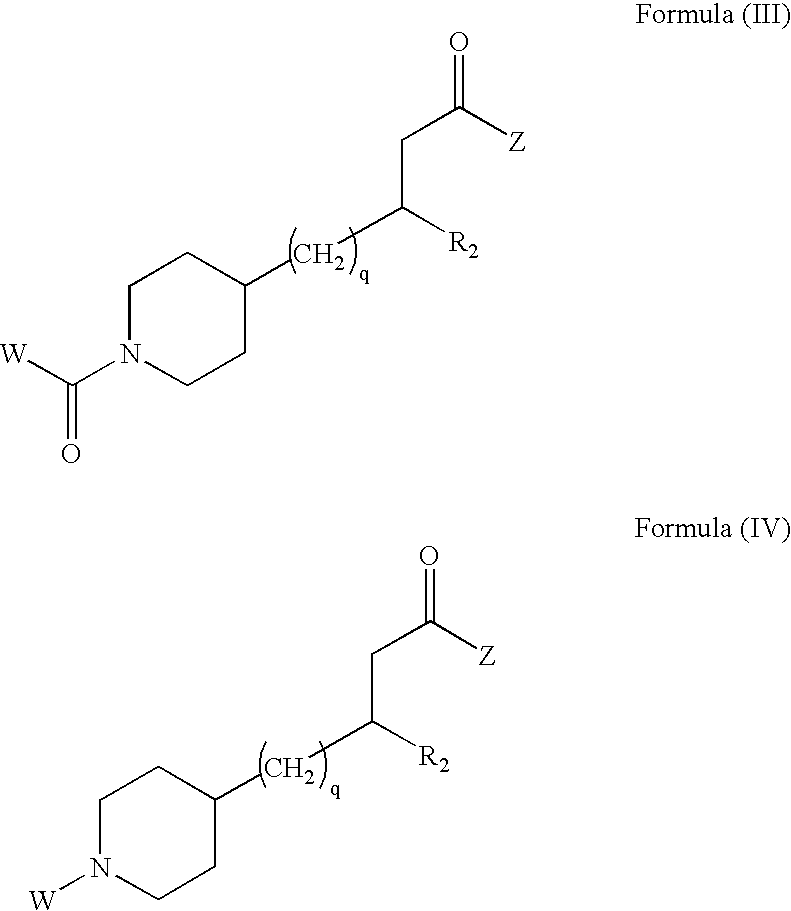Enantioselective process for preparing a substituted alkanoic acid
- Summary
- Abstract
- Description
- Claims
- Application Information
AI Technical Summary
Benefits of technology
Problems solved by technology
Method used
Image
Examples
synthetic example 1
Ru Adduct Complex Hydrogenation of Compound C1
[0792]Various basic-screening, preformed Ru adduct complexes were reacted with Compound C1 (82 mg, 0.2 mmol) in a 50:1 substrate: complex ratio in various solvents (3 mL) at a temperature of about 50° C., under H2 pressure of about 360 psig (25 bar) for a period of about 16 to about 18 hours. The percent conversion and e.e. were determined by HPLC (210 nm).
TABLE 1EntryComplexSolventConve.e.1(S)-P-Phos / [RuCl2(DMF)2]MeOH62(S)-P-Phos / [RuCl2(DMF)2]DCEND3(S)-Xyl-P-Phos / [RuCl2(DMF)2]MeOH6 8 (S)4(R)-Me-BoPhoz / [RuCl2(DMF)2]MeOH823 (S)5(S)-P-Phos / [Ru(benzene)Cl]ClMeOH815 (S)6(S)-P-Phos / [Ru(benzene)Cl]ClDCEND7(R)-Xyl-P-Phos / [Ru(p-cymene)Cl]ClMeOHND8(R)-Xyl-P-Phos / [Ru(p-cymene)Cl]ClDCE1059 (R)
[0793]The results of Synthetic Example 1 show that the conversion and e.e. are dependent on both the solvent and ligand chosen. The reaction also may need to be run at a higher temperature in order to obtain improved percent conversion and e.e.
synthetic example 2
Rh-BoPhoz Hydrogenation of Compound C1
[0794]Various Rh-BoPhoz complexes formed in situ from ligand and [Rh(COD)2]OTf were reacted with Compound C1 (82 mg, 0.2 mmol) in a 50:1 substrate:complex ratio in various solvents (3 mL) at a temperature of about 50° C., under H2 pressure of about 360 psig (25 bar) for a period of about 16 to about 18 hours. The percent conversion and e.e. were determined by HPLC (210 nm).
TABLE 2EntryLigandSolventConve.e.1(R)-Me-BoPhozMeOH1541 (S)2CF3Ph-(R)-Me-BoPhozMeOH1437 (S)3(R)-iPr-BoPhozMeOH1345 (S)4(S)-Binol-(R)-Me-BoPhozMeOH6 7 (S)5(R)-Me-BoPhozDCE8>90 (S) 6CF3Ph-(R)-Me-BoPhozDCE777 (S)7(R)-Me-BoPhozTHF1080 (S)8CF3Ph-(R)-Me-BoPhozTHF1085 (S)
[0795]Generally, the enantioselectivity obtained in aprotic solvents (such as THF and DCE) was improved over MeOH, even though MeOH provided improved conversion for a given complex. However, the low reactivity for conversion of the substrate may be attributable to coordination of the quinoline ring nitrogen atom to ...
synthetic example 3
Phanephos-Rh Hydrogenation of Compound C1
[0796]A preformed (S)-PhanePhos / [Rh(COD)]BF4 complex was reacted with Compound C1 (82 mg, 0.2 mmol) in a 50:1 substrate:complex ratio with various acid additives in MeOH (3 mL) at a temperature of about 50° C., under H2 pressure of about 360 psig (25 bar) for a period of about 16 to about 18 hrs. The percent conversion and e.e. were determined by HPLC (210 nm).
TABLE 3EntryAdditive (Eq)Conve.e.1TsOH (1 Eq.)2767 (R)2TsOH (0.2 Eq.)1677 (R)3AcOH (1 Eq.)1367 (R)4AcOH (0.2 Eq.)1464 (R)5HBF4 (1 Eq.)3775 (R)6HBF4 (1 Eq.)2585 (R)7No Additive14
[0797]Generally, percent conversion obtained (compared to a reference Entry 7) was improved (see Entries 1, 5, and 6) by the use of an additive (in a range of from about 0 Eq to about 1.2 Eq) to reduce the coordinative effect of the quinoline ring nitrogen atom on the complex.
[0798]The improvement to conversion and enantioselectivity was achieved by the optional use of an additive to reduce the coordinative effec...
PUM
| Property | Measurement | Unit |
|---|---|---|
| Temperature | aaaaa | aaaaa |
| Temperature | aaaaa | aaaaa |
| Temperature | aaaaa | aaaaa |
Abstract
Description
Claims
Application Information
 Login to View More
Login to View More - R&D
- Intellectual Property
- Life Sciences
- Materials
- Tech Scout
- Unparalleled Data Quality
- Higher Quality Content
- 60% Fewer Hallucinations
Browse by: Latest US Patents, China's latest patents, Technical Efficacy Thesaurus, Application Domain, Technology Topic, Popular Technical Reports.
© 2025 PatSnap. All rights reserved.Legal|Privacy policy|Modern Slavery Act Transparency Statement|Sitemap|About US| Contact US: help@patsnap.com



